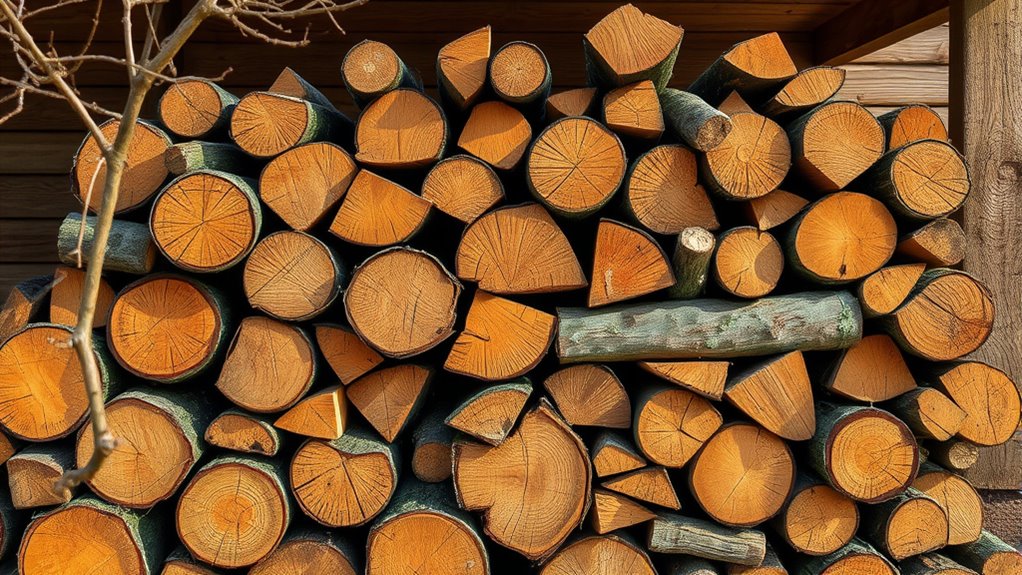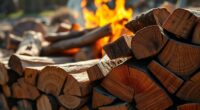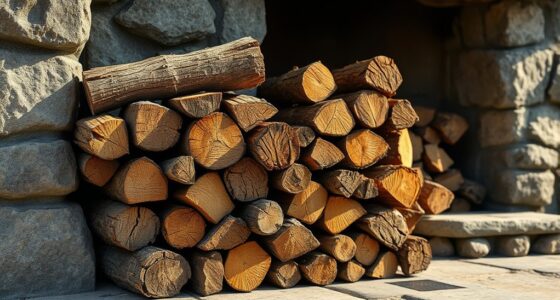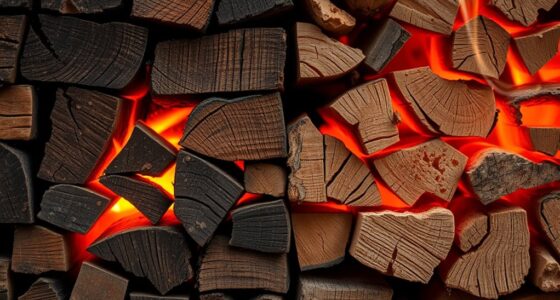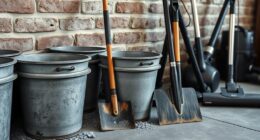To maximize firewood seasoning, stack logs in a crisscross or row pattern with cut ends facing the same direction for airflow. Keep the pile elevated on pallets or blocks to prevent ground moisture and pests. Cover the top with a breathable or waterproof tarp that extends beyond the edges, but leave sides open to prevent trapped humidity. Regularly check for pests and moisture, making adjustments as needed. Continue exploring for more tips to guarantee your firewood dries efficiently and stays pest-free.
Key Takeaways
- Elevate firewood off the ground using pallets or racks to prevent moisture absorption and pest infestation.
- Stack logs in stable, well-ventilated rows with cut ends facing the same direction for efficient airflow.
- Cover the top of the pile with a breathable or waterproof tarp that extends beyond the edges, avoiding sides.
- Split logs prior to stacking to accelerate drying and promote even seasoning.
- Regularly inspect the stack for signs of excess moisture or pests, removing affected logs promptly.

Properly stacking and storing firewood is essential to guarantee it stays dry, seasoned, and ready to burn. When you focus on moisture control, you prevent the wood from absorbing excess water, which can lead to mold, rot, and inefficient burning. Ensuring good airflow around your woodpile helps moisture escape, making your firewood burn hotter and cleaner. You should stack the logs in a way that allows air to circulate freely, avoiding tightly packed piles that trap humidity. Elevate the wood off the ground on pallets, concrete blocks, or a firewood rack to prevent ground moisture from seeping in and to discourage pests from nesting underneath. Keeping the wood off the soil also accelerates drying, ensuring your firewood stays properly seasoned. Efficiency ratings of your storage setup can help optimize drying times and prevent energy loss during burning.
Pest prevention is another critical aspect of storing firewood correctly. When wood is stored improperly, it creates an inviting environment for insects, rodents, and other pests. To minimize this risk, stack your firewood away from your home’s foundation and other structures. This distance reduces the chance of pests migrating into your house and makes it easier to monitor your woodpile for signs of infestation. Cover the top of your stack with a breathable tarp or a waterproof cover that extends beyond the pile’s edges. This protects the wood from rain and snow while still allowing air to circulate, preventing moisture buildup that pests thrive in. Avoid covering the sides completely, as airtight conditions can trap humidity and create a breeding ground for mold and pests.
The ideal firewood storage encourages consistent seasoning. Split logs dry faster and more evenly than whole rounds, so split your wood before stacking. Stack the pieces with the cut ends facing in the same direction to promote uniform airflow. Arrange your logs in rows or crisscross patterns, depending on space and preference, but always keep the stack stable and accessible for inspection. Regularly check the pile for signs of pests or excess moisture. If you notice dampness or signs of insects, take action immediately by removing affected logs and adjusting your storage setup.
Frequently Asked Questions
How Do I Prevent Pests From Infesting My Firewood?
To prevent pests from infesting your firewood, start with pest prevention by keeping wood off the ground and away from your home’s exterior. Use storage tips like stacking wood neatly and covering it with a breathable tarp. Regularly check for signs of pests and remove any infested pieces promptly. Proper ventilation and maintaining dryness also help deter pests, ensuring your firewood stays pest-free and ready to burn.
What Is the Ideal Humidity Level for Seasoned Firewood?
Think of your firewood as a delicate balance in a dance. You want the humidity level to be around 20%, like a calm, steady heartbeat. Maintaining this involves moisture content and humidity control, ensuring the wood dries properly without becoming too dry or too damp. This way, your firewood ignites easily, burns efficiently, and lasts longer, giving your hearth the warmth it deserves.
Can I Store Firewood Indoors Safely?
You can store firewood indoors safely if you follow proper indoor storage practices. Make certain good ventilation to prevent moisture buildup, which can cause mold or pests. Keep the firewood away from your home’s main living areas to reduce fire hazards. Use a dedicated, well-ventilated space like a basement or garage, and avoid stacking firewood directly on the floor to enhance firewood safety and keep your indoor environment safe and dry.
How Often Should I Rotate My Firewood Stacks?
Like a well-tuned clock, you should rotate your firewood stacks every few months to ensure even seasoning. Check the moisture content regularly, aiming for below 20%, to prevent mold and decay. Use proper stacking techniques that promote airflow, such as staggering the logs and leaving space between them. This way, you maintain ideal dryness, and your firewood stays ready for burning whenever you need it.
What Are the Signs of Improperly Seasoned Firewood?
You’ll notice improperly seasoned firewood has high moisture content, making it heavy and hard to light. It often produces excessive smoke and sparks, and the wood may crack or pop when burned. If the firewood feels damp, smells musty, or doesn’t produce a steady flame, it’s a sign it needs more time to season. Properly seasoned wood should sound hollow when tapped and burn cleanly with less smoke.
Conclusion
By stacking and storing your firewood properly, you guarantee it seasons thoroughly, much like a fine wine matures over time. Keep it off the ground, in a sunny, well-ventilated spot, and use a cover to protect from rain. Doing so not only improves burning efficiency but also extends the wood’s lifespan. Think of your firewood as a valuable treasure—carefully stored, it’ll serve you well for many cozy fires ahead.

